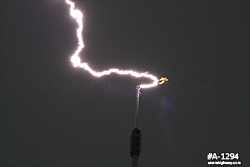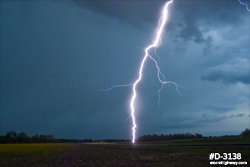MYTH: Surge protectors and UPS devices provide total lightning protection.
|
In September of 2025, my work is generating the most income it ever has in my career. Yet, I'm being forced to shut down my successul operation, against my will, due to one cause alone: 95% of that revenue is being stolen by piracy and copyright infringement. I've lost more than $1 million to copyright infringement in the last 15 years, and it's finally brought an end to my professional storm chasing operation. Do not be misled by the lies of infringers, anti-copyright activists and organized piracy cartels. This page is a detailed, evidenced account of my battle I had to undertake to just barely stay in business, and eventually could not overcome. It's a problem faced by all of my colleagues and most other creators in the field. |
TRUTH: Unfortunately not. A common surge protector will stop voltage spikes and surges, but not the violent, catastrophic burst of current from a close lightning strike. Direct lightning current is simply too big to protect with a little electronic device inside a power strip, or even a hefty UPS unit. If your UPS or surge protector is in the way of the lightning's path, all or part of the lightning will just flash over or through the device - regardless of the amount of capacitors and battery banks involved.
 RIGHT: Television/radio towers are freqently struck by lightning. As a result, they have some of the most robust lightning protection systems available, but damage to equipment still occurs on occasion. RIGHT: Television/radio towers are freqently struck by lightning. As a result, they have some of the most robust lightning protection systems available, but damage to equipment still occurs on occasion.
Even 'disconnects', or devices that physically switch off power to a device by activating a set of contacts, will not guarantee protection. A small air gap will not stop a lightning bolt that has already jumped across miles of air. It won't think twice about jumping a few more inches, or even a few more feet, especially if the 'path of least resistance' to ground is across the contacts of the disconnect switch.
While full-fledged lightning protection systems with rods, cables and solid grounding often provide a good degree of defense against a direct strike, they cannot absolutely guarantee against damage to electronics and computers. For any system to provide true 100% protection, it must divert close to 100% of the lightning current from a direct strike every time - no easy task. Ohm's Law states that for a set of resistances connected in parallel, the current will be distributed across ALL resistances, at levels inversely proportional to the different values of resistance. A house or building is nothing more than a set of resistors 'connected' in parallel- the electrical wiring, plumbing, phone lines, steel framework, etc. (Even though plumbing and electrical wiring, for instance, may not be physically connected, lightning will use side flashes across air gaps to effectively connect them). In a direct lightning strike, the current will not follow only one path- it will distribute itself across all paths to ground depending on each path's resistance.
Lightning current often peaks at 100,000 or more Amperes. With that in mind, consider if you have a lightning protection system installed, and your house is hit directly by lightning. If the protection system takes even 99.9% of the current, then your electrical wiring may take the remaining 0.1%. 0.1% of 100,000 Amperes is a 100 Amp surge through your lines- which may be enough to take out your computer.
 It is not uncommon for 'side flashes' to occur inside a house or building, where all or a part of the lightning will jump across an entire room to reach ground- such as from the electrical wiring system to well-grounded water pipes. If your computer is in the way, it'll be time to shop for a new one, even if you have the most expensive protection system installed. It is not uncommon for 'side flashes' to occur inside a house or building, where all or a part of the lightning will jump across an entire room to reach ground- such as from the electrical wiring system to well-grounded water pipes. If your computer is in the way, it'll be time to shop for a new one, even if you have the most expensive protection system installed.
A 'side flash' often occurs when lightning branches out into several channels as it tries to bury itself deep into earth. So even if the bulk of the current is flowing to ground through the heavy cables of your protection system, there can be small 'overflow' disharges, even if the lightning hits outside of the structure. Such an event was experienced by my Grandmother, who witnessed a 6-foot long blue spark jump across the room from a wall outlet to the kitchen faucet as lightning struck nearby.
Guarantees on the packaging of UPS/surge protection devices are somewhat misleading when it comes to lightning protection, implying that the devices can stop any effects of a strike. In some cases, they will - as long as they aren't in or near the direct line of fire. But in reality, nothing can guarantee absolute protection from a direct or very close strike.
All this doesn't mean that you shouldn't use a surge protector, UPS, disconnect, or a full-fledged lightning protection system. Any device will provide some degree of protection from everyday power line spikes and distant lightning strikes. But when lightning hits nearby or directly, all bets are off.
The best, and cheapest, way to protect your stereo, television, computer, or any electronic appliance is to unplug all power, telephone (modem), and antenna connections during a thunderstorm.
Some could argue that the risk of a direct strike to any given house is too low to justify unplugging everything for every storm that passes overhead. There is some truth to that. It's wise then to make sure your homeowner's or renter's insurance covers lightning damage, and all of your devices are inventoried and covered by the policy. Insured expensive electronics can be replaced, after all. However, consider irreplaceables such as the data saved on your computer (photos, videos, work files, etc). You can mitigate that risk by performing frequent offsite backups and/or storing data on an external hard drive that you can unplug when needed.
READ: More Weather Myths | Weather Library Home
 About the Author: Dan Robinson has been a storm chaser, photographer and cameraman for 33 years. His career has involved traveling around the country covering the most extreme weather on the planet including tornadoes, hurricanes, lightning, floods and winter storms. Dan has been extensively published in newspapers, magazines, web articles and more, and has both supplied footage for and appeared in numerous television productions and newscasts. He has also been involved in the research community, providing material for published scientific journal papers on tornadoes and lightning. |
< Back to Weather Library
Related lightning topics:
GO: Home | Storm Chase Logs | Photography | Extreme Weather Library | Stock Footage | Blog
Featured Weather Library Article:
|